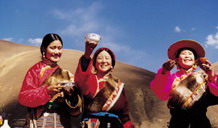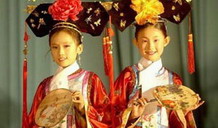Hui Ethnic Group
With a sizable population of 8.61 million (as of 1990), the Hui ethnic minority is one of China's largest and most widely distributed ethnic minorities. People of Hui origin can be found in most of the counties and cities throughout the country, especially in the Ningxia Hui Autonomous Region and Gansu, Qinghai, Henan, Hebei, Shandong and Yunnan provinces and the Xinjiang Uygur Autonomous Region.
The Hui people took Chinese as their common language. During their long history, the Hui people, aided by the Han people, accumulated great wealth. Their development and progress have been facilitated, however, by adopting the Han language and living with the Hans. Some of the Hui people are good at Arabic and Farsi.
Its origin can be trace back to the middle of the 7th century, when Islamic Arabs and Persians came to China to trade and later some became permanent residents of such cities like Guangzhou, Quanzhou, Hangzhou, Yangzhou and Chang'an (today's Xi'an). These people, referred to as "fanke" (guests from outlying regions), built mosques and public cemeteries for themselves. Some married and had children who came to be known as "tusheng fanke", meaning "native-born guests from outlying regions". These people later became part of the Hui ethnic minority.
In the early years of the 13th century countless Islamite from Middle Asia, Persia and Arabia migrated voluntarily or compulsorily into China. As artisans, tradesmen, scholars, officials and religious leaders, they spread to many parts of the country and settled down mainly to stockbreeding. It was during the Ming Dynasty (1368-1644) that the Huis began to emerge as an ethnic minority.
The Huis of today are therefore an ethnic minority that finds its origins mainly with the above-mentioned two categories, which in the course of development took in people from a number of other ethnic minorities including the Hans, Mongolians and Uygurs. It is generally acknowledged that Hui culture began mainly during the Yuan Dynasty.
The Hui people are mainly involved in agriculture; they also keep livestock, produce and trade handicrafts and food as well. Traditional items of trade are jewelry, jade and bullion.
The Islamic religion had a deep influence on the life style of the Hui people. The mosque is also a symbol of Hui architecture. According to the Hui's dietary rules, the meat of pig, dog, horse, donkey, mule as well as all birds and beasts of prey is not allowed. They are also prohibited from eating the blood of any animal, and from eating any living that dies naturally. Alcoholic drink is strictly forbidden. These taboos originated in the Koran of the Moslems. The Huis are very particular about sanitation and hygiene. Likewise, before attending religious services, they have to observe either a "minor cleaning," i.e. washing their face, mouth, nose, hands and feet, or a "major cleaning", which requires a thorough bath of the whole body.
The main festivals of the Hui ethnic minority are the Kaizhai Festival, Corban Festival and Almsgiving Festival.
Editor: Feng Hui





